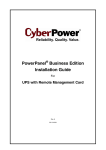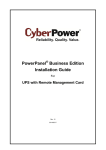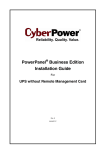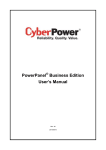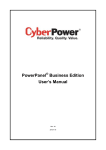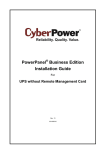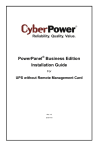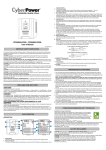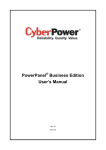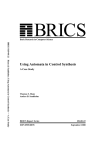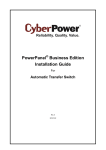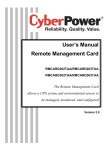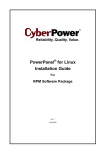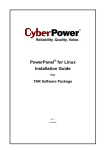Download User`s Manual PowerPanel Business Edition
Transcript
PowerPanel® Business Edition Installation Guide User’s Manual For PowerPanel Business Edition UPS without Remote Management Card Rev. 1.5.11 2009/09/03 Rev. 5 2011/10/04 Table of Contents Introduction ...................................................................................................................................................... 3 Hardware Installation ...................................................................................................................................... 3 Connect Computer’s Power with UPS Correctly ........................................................................................... 3 Ensure USB or Serial Cable between Computer and UPS is Connected Properly ...................................... 4 Installing PowerPanel® Business Edition Software ..................................................................................... 4 Installation on Windows................................................................................................................................. 4 Installation on Linux....................................................................................................................................... 7 Installation on Citrix XenServer and VMware ESX/ESXi ............................................................................ 10 Access PowerPanel® Business Edition Software Interface ...................................................................... 12 Setup Necessary Shutdown Time ................................................................................................................ 12 Configure Power Protection for More Computers ..................................................................................... 12 Assign Agent’s IP Address and Connected Outlet in Client........................................................................ 12 Configure Shutdown Action for VMware ESXi ............................................................................................ 13 Configure Shutdown Action for Citrix XenServer ........................................................................................ 13 Configure Startup and Shutdown of Virtual Machines on VMware ESX/ESXi ............................................ 13 Manage UPS Units in Center ........................................................................................................................ 14 Add UPS Units ............................................................................................................................................ 15 2 Introduction PowerPanel® Business Edition software provides for the power management and unattended/automatic shutdown of PCs and servers connected to the UPS. When one computer is supplied power by the UPS and communicates with the UPS through the USB or serial connection, installing PowerPanel® Business Edition Agent on this single computer can initiate a shutdown in the event of the power outage to prevent the hosted computer from experiencing data loss. Computers which are also supplied power by the UPS can be protected by installing Client. The Agent establishes communication with the Client via the network and relays the UPS state to the Client. Before the UPS stops supplying power to the Client computer, the Client will be ordered to perform an early, graceful shutdown by the Agent. Hardware Installation Connect Computer’s Power with UPS Correctly UPS outlets may have different functions: Surge + Battery protected outlets provide protection for the equipment connected to them and supply battery power once power outage occurs. Surge protected outlets provides protection for the equipment but does not provide battery power when a power outage occurs. The Agent computer should be connected to the UPS in one of the Surge + Battery protected outlets instead of a Surge outlet. On specific modes, NCL (Non-critical load) outlets are designed to turn off early to save battery power in order to maximize the battery runtime for the remaining outlets. The Agent computer also should be not plugged into these NCL outlets. Determine which outlet should be used by the Agent computer according the following: Smart App Online series. 3 Outlets numbered 1 or 2 are NCL. The Agent computer should be plugged into one of the other outlets instead of these numbered ones. Smart App Sinewave series and Professional Rack Mount LCD series. The Agent computer should be plugged into one of outlets labeled CRITICAL LOAD. Smart App Intelligent LCD series. The Agent computer should be plugged into one of outlets labeled SURGE + BATTERY. Note: The Agent computer should also be plugged into one of outlets labeled SURGE + BATTERY in other series such as the Smart App AVR series, Adaptive SinewaveTM series, Intelligent LCD series, AVR series, Standby series, BS series, DX series, BRICs series, BRICs LCD series, Office Rack Mount series and Office Tower series. Value series, Value GP series, Value GP LCD series and Paragon Tower series. y The Agent computer can be plugged into any of the outlets. Professional Rack Mount series. y The Agent computer should be plugged into one of black outlets. Professional Tower series. y The Agent computer should be plugged into one of outlets labeled CRITICAL LOAD OUTLET BANK. Ensure USB or Serial Cable between Computer and UPS is Connected Properly Make sure the connection between the Agent computer and the UPS is securely connected. The Agent will not monitor the UPS status if the communication is lost. If Agent is installed on VMware vMA in ESX and ESXi, USB device or serial cable which connects to the UPS should be assigned to vMA manually. Refer to FAQ chapter of PowerPanel Business Edition User’s Manual for further steps to assign USB or serial cable to vMA. Note: USB device passthrough from an ESX or ESXi host to the vMA is supported from ESX/ESXi 4.1. Note: Citrix XenServer 5.0 and later versions support USB device. Installing PowerPanel® Business Edition Software If a single computer has a USB or serial connection to UPS, the Agent should be installed on this computer. If multiple computers plugged into the UPS, the computers without the USB or serial connections should install the Client. The PowerPanel Business Edition software is compatible with Windows, Linux, Citrix XenServer and VMware ESX/ESXi systems. Installation on Windows A popup window will be displayed automatically when inserting the PowerPanel® Business Edition installation CD. Users can click the Install PowerPanel Business Edition software shortcut on the popup page to 4 initiate the installation procedure. If the popup window is not displayed when inserting the CD, browse to the CD drive and open the folder which locates at /Software/Windows then double click the file named Setup.exe to start the installation procedure. To install follow these steps: z Click the Next button to start an installation. z Accept the license agreement. z Choose the component. If the target computer is connected to the UPS directly via a USB or serial connection, Agent should be installed. If the computer does not have a USB or serial connection to the UPS, or the computer is powered by a UPS with a remote management card or a PDU, Client should be installed. If multiple UPS units require monitoring, Center should be installed. 5 Note: The Agent, Client and Center cannot be installed at the same time. z Choose the destination directory. z Choose the start menu folder. 6 z Click the Finish button to complete the installation. Installation on Linux The installer is used to install the PowerPanel Business Edition software and requires root permission. The installation wizard will guide users to complete the installation. Browse to the CD drive and find the installer in the /Software/Linux folder. Initiate an installation wizard by running ./ppbe210-linux-x86.sh command or double clicking ppbe210-linux-x86.sh from desktop on 32-bit systems. Initiate an installation wizard by running the ./ppbe210-linux-x86_64.sh command or double clicking ppbe210-linux-x86_64.sh from desktop on 64-bit systems. Note: On Linux, users may mount the CD by using the mount command. Run mount –t iso9660 /dev/cdrom /mnt/cdrom as a root user. /dev/cdrom is the CD drive and /mnt/cdrom will be the mount point. 7 To install follow these steps: z Click the Next button to start an installation. z Accept the license agreement. z Choose the component. If the target computer can communicate with UPS directly via a USB or serial connection, Agent should be installed. If the computer does not have a USB or serial connection to the UPS, or the computer which is powered by the UPS with a remote management card or a PDU, Client should be installed. If multiple UPS requires a synchronous monitoring, Center should be installed. Note: The Agent, Client and Center cannot be selected to install at the same time. 8 z Choose the destination directory. z The daemon ppbed will start during installation. Click Next button to continue. 9 z Click the Finish button to complete the installation. Note: If the Linux installation needs to be initiated in the terminal, use the ./ppbe210-linux-x86.sh -c command on 32-bit Linux systems or use ./ppbe210-linux-x86_64.sh -c command on 64-bit Linux systems. The detailed installation steps are described in Installation on Citrix XenServer and VMware ESX/ESXi section. Installation on Citrix XenServer and VMware ESX/ESXi The installer is used to install the PowerPanel Business Edition software and requires root permission. The installation wizard will guide users to complete the installation. Browse the CD drive and find the installer in the /Software/Linux folder. Initiate an installation procedure by running the ./ppbe210-linux-x86.sh command on Citrix XenServer or running the ./ppbe210-linux-x86_64.sh command on VMware ESX/ESXi. 10 Installation for ESX host must be launched on the Service Console (aka Console Operation System); installation for ESXi host must be launched on the vMA (vSphere Management Assistant). Agent should be installed on the vMA of ESX/ESXi 4.1 or later versions, and Center and Client should be installed on the Service Console in ESX or on the vMA in ESXi. Note: On ESX/ESXi, users may mount the CD by using the mount command. Run mount –t iso9660 /dev/cdrom /mnt/cdrom as a root user. /dev/cdrom is the CD drive and /mnt/cdrom will be the mount point. Note: Users can deploy vMA on VMware ESXi-. Visit VMware website for vSphere Management Assistant Guide document about vMA deployment on VMware ESXi. Note: On VMware ESXi, users can also upload the installer to vMA by using vSphere Client tool. Visit VMware website to download vSphere Client tool and refer to FAQ chapter of PowerPanel Business Edition User’s Manual to know how to upload installer by using vSphere Client tool. The installation procedure will be initiated as following steps: z Press Enter to start an installation. z Accept the license agreement. z Choose the component. If the target computer can communicate with UPS directly via a USB or serial connection, Agent should be installed. If the computer does not have a USB or serial connection to the UPS, or the computer which is powered by the UPS with a remote management card, Client should be installed. If multiple UPS requires a synchronous monitoring, Center should be installed. z Choose the destination location. z Installation procedure starts and once finished. It will end automatically. 11 Access PowerPanel® Business Edition Software Interface To access the Agent web interface in Windows, go to Start > All Programs > CyberPower PowerPanel Business Edition > PowerPanel Business Edition Agent or PowerPanel Business Edition Client or PowerPanel Business Edition Center), which will take you to the login page. On Linux, user can enter the URL as http://127.0.0.1:3052/ in the address of the web browser to access to the interface. Users can also enter the URL, http://127.0.0.1:3052/ in the local computer or http://hosted_computer_ip_address:3052/ in the remote computer, to the address field of the web browser to access the PowerPanel® Business Edition software web interface. hosted_computer_ip_address is the IP address of the computer which has the PowerPanel® Business Edition software installed. For vMA on the ESX or ESXi, hosted_computer_ip_address is the IP address of the vMA (Note: hosted_computer_ip_address is the IP address of the host computer on ESX.). The default username is admin and default password is admin. For security consideration, it is recommended to change the login username and password after the initial login. Setup Necessary Shutdown Time Each computer running the Agent or the Client requires a sufficient time to be shut down completely before the UPS stops supplying power. Therefore users should set up this sufficient time at the Necessary shutdown time option on the Event Action/Settings page in the Agent and the Client. Configure Power Protection for More Computers In order to ensure that computers connected to the UPS have sufficient time to complete the shutdown prior to the outlets turning off, Client should be installed. The Client will establish communication with the Agent and receive commands from the UPS for a complete shutdown to avoid data loss or a system crash. Refer ® to Install PowerPanel Business Edition Software to installing the Client. Assign Agent’s IP Address and Connected Outlet in Client Users must assign the Agent's IP address and connected outlet on the Power/Configuration page in Client to establish communication through the network. In order for Agent to respond the Client normally, the secrete phase configuration must be setup properly. Assign the IP address of Agent computer at the Address field or pick an address from the device list which shows all devices on the local network. Users have to assign the correct outlet which supplies power to the Client computer according to actual connection. Click Apply button for Client to establish the communication with Agent. Note: More Clients can also establish communications by assigning IP addresses and connected outlets on the UPS/Load page in Agent. Users can complete configurations to multiple Clients in Center easily. 12 Configure Shutdown Action for VMware ESXi In order to assure the ESX/ESXi host and all virtual machines can be shut down correctly in case of power events, users have to configure the ESXi host address, account and password of root user for the host shutdown from vMA. Fill in the Host Address, Account and Password fields with actual username and password for ESXi host on the Event Action/Settings page. Due to PowerPanel Business Edition software is installed on the Service Console of ESX instead of vMA, Event Action/Settings page does not provide these settings for users to configure. Note: Host Address is the IP address of the ESXi host computer on which vMA is operating but not the IP address of vMA. Note: In order to allow the interactions between physical and virtual machines, VMware tools have to be installed on each virtual machine. Refer to VMware ESX/ESXi Server documentation for further information about VMware Tools. Configure Shutdown Action for Citrix XenServer In order to assure the XenServer server host and all virtual machines can be shutdown correctly, users have to configure the account and password of root user for host shutdown. Fill in the Account and Password fields with actual username and password for shutdown action on the Event Action/Settings page. Configure Startup and Shutdown of Virtual Machines on VMware 13 ESX/ESXi In order to assure that all virtual machines could be shut down and restart gracefully: z Select the topmost ESX/ESXi server host from the tree hierarchy on the right side. Go to Configuration > Virtual Machine Startup/Shutdown menu > Properties of the vSphere Client. z Enable the Allow virtual machines to start and stop automatically with the system option. Manage UPS Units in Center If the administrator requires monitoring multiple UPS units on the local network at one time, PowerPanel® Business Edition Center should be installed. The Center will track the state and events from the monitored UPS units and monitored UPS units can accept commands from the Center for shutting off or restarting. Refer 14 to Install PowerPanel Business Edition Software chapter for further details about Center installation. The Center can also establish communication with the multiple PDUs and UPS units with Remote Management Card. Monitored PDUs and UPS units will relay the state to the Center and notify Center what power event occurs. Add UPS Units Users can monitor and control multiple UPS on the Management/Power Equipment page by accessing the Add Device window to add UPS units to Center as below: The Add Device window can be accessed by clicking the Add Device button of the toolbar or selecting Add Device of the context menu of any one group node. Either enter the IP address of UPS RMCARD on the Device Address field or click the Browse button to display the device list and select the IP address from the list. Click OK to proceed to add the selected UPS. 15 Note: If users need to add more UPS units to Center, please repeat steps the aforementioned steps Note: Please refer to PowerPanel Business Edition User’s Manual about further details of more functions about Center. 16
















